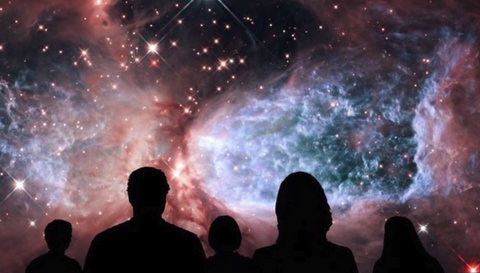
Earth-size Planets Around Nearby Dwarf Star
Astronomers just discovered three planets, two of which are roughly the size of Earth, orbiting a dim nearby dwarf star. Their proximity makes their atmospheres ripe for observing.

Speedy Stars Weigh Milky Way’s Dark Matter Halo
It’s a bird! It’s a plane! It’s a . . . pair of hypervelocity stars? The surprising stellar duo may place constraints on the mass of our galaxy’s unseen dark matter halo.

NASA's Kepler Spacecraft Recovered from Emergency Mode
The Kepler team unexpectedly found the planet-hunting spacecraft in emergency mode on April 7th, but with the spacecraft recovered, hopes are high that its newest search, this time for rogue planets, is still on. Read on to see how amateur observations can help!

Dark Dwarf Galaxy Discovered
Astronomers using the ALMA array of radio dishes have detected a dwarf galaxy 4 billion light-years away by the pull of its dark matter.

April 1st Astronomy Hijinks
In breaking news today, astronomers have discovered Pi in the sky, proposed a revolutionary search for extraterrestrial environmentalism . . . and oh yes, April Fools’!

Hot Nights, Hotter Days on Exoplanet 55 Cancri e
A new thermal map of a super-Earth exoplanet is puzzling astronomers.

Hidden Galaxies Revealed
Astronomers studying the infrared glow that pervades the universe have pinned down its source: dusty, faint, and faraway galaxies.

Galactic Archaelogy in the Milky Way Halo
The motions of thirteen stars in our galaxy’s halo outline a shell-like structure, perhaps the remains of an ancient galactic collision.

Hubble Finds Most Distant Galaxy Yet
Astronomers using the Hubble Space Telescope have measured a precise distance to a galaxy dwelling in the cosmic dawn.

A Cold New View of the Milky Way Galaxy
A stunning submillimeter mosaic of the Milky Way Galaxy captures a portrait of the cold dust and gas swirling along the galactic plane.

Hubble Sheds Light on Super Exoplanets
New observations from the Hubble Space Telescope are helping characterize the atmospheres of exotic planets such as 55 Cancri e.

AAS Adopts Worldwide Telescope
The largest national association of astronomers is now the new home of a virtual observatory known as the WorldWide Telescope.

The Case of the Disappearing Quasar
When a quasar, a black hole-fueled beacons that shines from across the cosmos, went dark, astronomers set out to find out why.

Brightest Supernova Baffles Astronomers
The most luminous supernova ever discovered, ASASSN-15lh, challenges a popular theory for blazingly bright exploding stars.

Charting 70,000 Stars in the Milky Way
Astronomers have created an age-map of 70,000 stars spanning our galaxy, ushering in a new era of galactic archaeology.

CubeSats: Future Solar System Explorers?
An innovative and tiny thruster design could prove the future of interplanetary exploration with the tiny satellites known as CubeSats.

Astronomers Predict a Supernova
For the first time, astronomers have predicted the appearance of a supernova.

Hubble Peers Inside Exoplanets' Atmospheres
Astronomers studying hot Jupiter exoplanets revealed when and how clouds form on these alien worlds.

Kepler’s Giant Exoplanet Candidates — Real or Not?
A new study shows that about half of Kepler’s giant exoplanet candidates aren’t real planets. But astronomers expected this.

Simulation Sees Supernova Innards
A new computer simulation provides a brief glimpse at what makes stellar bombs tick.
